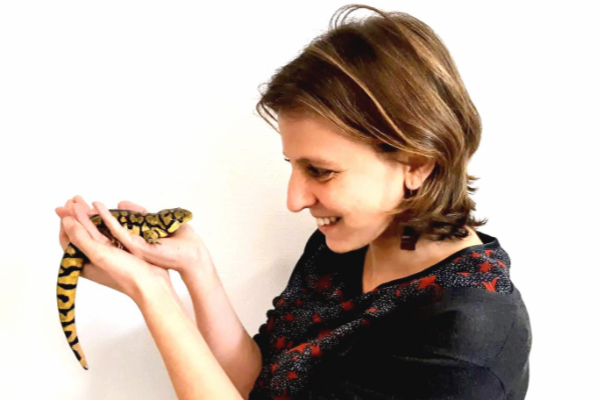séminaire vendredi 14 octobre 2022
 Development as a driver or a brake of morphological diversity?
Development as a driver or a brake of morphological diversity?
Anne-Claire Fabre (Assistant Professor, Institute of Ecology & Evolution, université de Bern, Suisse)
Vendredi 14 octobre à 14 h 30, amphi Ampère
Metamorphosis is one of the most fascinating and spectacular developmental processes in the animal kingdom, often implying an abrupt change in morphology and ecology during the lifetime of an individual transforming it from a larva into an adult. It can be seen as a second birth for an animal, marking the end of larval life. However, the origin and evolution of metamorphosis as well as its impact on morpho-functional variation remains rather poorly understood. As natural selection targets all components of an animal’s life cycle, studying all life-history stages is essential in order to understand how development impacts adult diversity. For some amphibians (including salamanders), a simplification of development in the terrestrial environment can have major ecological and evolutionary consequences as it allows a species to be emancipated from the aquatic environment during reproduction, thus allowing the colonization of new terrestrial habitats. Consequently, life cycle complexity can be expected in some cases to constrain or alternatively, in other cases, to facilitate the evolution of morphological structures and their diversity. In this study, we investigate the patterns of morphological and functional variation using adult and larval salamanders with different life-history strategies (bi-phasic, direct-developing, and paedomorphic). To do so, we reviewed the literature on the kinematics of feeding and acquired new data on feeding for six species including different life-history stages (i.e., paedomorphic and metamorphosed) for some species. In addition, we performed morphological analyses of the cranial system using geometric morphometrics. We explored the patterns of morphological and functional variation as well as the patterns of covariation using comparative and canonical analyses. Our results show strong differences in morphology and feeding kinematics depending on life-history stage and life cycle. Interestingly, species that rarely metamorphose in the wild retained an aquatic motor program despite feeding on land. Finally, we found covariation between the kinematics of feeding and cranial morphology suggesting that the constraints of feeding in different media drive the morphological evolution of the feeding system in salamanders.
- extrait:
- lien_externe:
- titre:
- intervenant:
- date:
- kc_data:
- a:8:{i:0;s:0:"";s:4:"mode";s:0:"";s:3:"css";s:0:"";s:9:"max_width";s:0:"";s:7:"classes";s:0:"";s:9:"thumbnail";s:0:"";s:9:"collapsed";s:0:"";s:9:"optimized";s:0:"";}
- kc_raw_content:
 Development as a driver or a brake of morphological diversity?
Development as a driver or a brake of morphological diversity?Anne-Claire Fabre (Assistant Professor, Institute of Ecology & Evolution, université de Bern, Suisse)
Vendredi 14 octobre à 14 h 30, amphi Ampère
Metamorphosis is one of the most fascinating and spectacular developmental processes in the animal kingdom, often implying an abrupt change in morphology and ecology during the lifetime of an individual transforming it from a larva into an adult. It can be seen as a second birth for an animal, marking the end of larval life. However, the origin and evolution of metamorphosis as well as its impact on morpho-functional variation remains rather poorly understood. As natural selection targets all components of an animal’s life cycle, studying all life-history stages is essential in order to understand how development impacts adult diversity. For some amphibians (including salamanders), a simplification of development in the terrestrial environment can have major ecological and evolutionary consequences as it allows a species to be emancipated from the aquatic environment during reproduction, thus allowing the colonization of new terrestrial habitats. Consequently, life cycle complexity can be expected in some cases to constrain or alternatively, in other cases, to facilitate the evolution of morphological structures and their diversity. In this study, we investigate the patterns of morphological and functional variation using adult and larval salamanders with different life-history strategies (bi-phasic, direct-developing, and paedomorphic). To do so, we reviewed the literature on the kinematics of feeding and acquired new data on feeding for six species including different life-history stages (i.e., paedomorphic and metamorphosed) for some species. In addition, we performed morphological analyses of the cranial system using geometric morphometrics. We explored the patterns of morphological and functional variation as well as the patterns of covariation using comparative and canonical analyses. Our results show strong differences in morphology and feeding kinematics depending on life-history stage and life cycle. Interestingly, species that rarely metamorphose in the wild retained an aquatic motor program despite feeding on land. Finally, we found covariation between the kinematics of feeding and cranial morphology suggesting that the constraints of feeding in different media drive the morphological evolution of the feeding system in salamanders.
